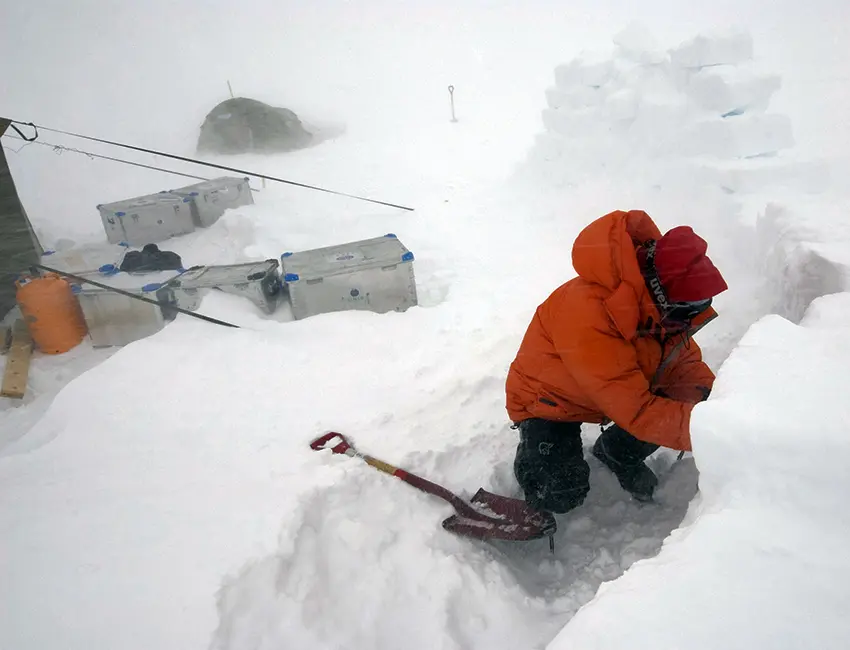AS-203 Arctic Safety and Field Leadership (15 ECTS)
ID:
AS-203
CREDITS:
15 ECTS
START DATE:
August 14, 2024
COURSE PERIOD:
Autumn and spring semester (August–May / June), annually. The start and end dates will be coordinated with the rest of the Arctic Nature Guide study.

Field camp, Northwestern Spitsbergen. Photo: Endre Før Gjermundsen/UNIS
| Grade: | Letter grade (A through F) |
| Course Cost: | None |
| Course Capacity Min/Max: | 10/30 |
| Language of instruction: | English |
| Examination support material: | All printed and written material |
Course requirements:
The course is not open for application. The course is mandatory for students enrolled in the Arctic Nature Guide study arranged by UiT The Arctic University of Norway.
Academic content:
The course is taught in parallel with other courses in the Arctic Nature Guide study. It is mainly practically oriented, but also includes a theoretical approach. It comprises field excursions and teaching in varied nature of the Arctic throughout the year. The course aims to gradually build up the students’ expertise in safety and leadership in the Arctic nature.
Main instructions and field work:
- Polar bear safety: Review of laws and regulations, safety in polar bear country and handling of conflict situations and encounters. Theory about polar bears and knowledge about procedures, includes practical shooting training and use of pyrotechnic for deterrent. Starts with focus on basic firearms skills and developed to scenario training including decision making and leading groups in encounters situations. Duration six days.
- Crisis management and leadership under challenging conditions: Theory and practical introduction to management principles, decision-making and accident scene command. Including knowledge of human achievements in an Arctic environment. Duration two and a half days.
- Safety management of field activities. Review of laws and regulations, theory and practical use of risk analysis, preparation of HSE plans and quality assurance of field activities with a risk-based approach. Duration two and a half days.
- Arctic first aid: Practical first aid training with focus on Arctic conditions and injuries related to activities on guided trips. The course and training according to the Norwegian Red Cross’ standards. Duration five days.
- Sea ice safety: Theory and practical training in travelling safely on sea ice. Include planning, procedures, organization, and travel with groups on sea ice. Practical training in self-rescue, buddy-rescue and use of safety equipment. Duration one and a half days.
- Snowmobile course: Review of laws and regulations, and training on driving a snowmobile in changing terrain. Also includes routines and procedures for leading larger groups on snowmobiles. Duration one and a half days.
- Maritime course: Planning of trips, knowledge of safety equipment, and rescue procedures. Duration one and a half days.
A more detailed program and learning goals for each course will be distributed at the start of each course.
Learning outcomes
Upon completing the course, the students:
Knowledge
- can apply knowledge of important topics, theories and methods in order to be able to plan safe travel, manage groups and handle emergency situations in the Arctic nature.
- will be familiar with best practices and be able to link this to relevant research and documented knowledge in the subject. This includes knowing about developments within the subject and the challenge that the Arctic context poses for human activity.
Skills
- can apply academic knowledge to practical and theoretical problems. The course also gives training in basic skills with an aim for building mental surplus for better decision-making in critical situations, main focus on:
- safety planning and safety management
- handling emergencies and accidents as a leader of a group
- safe handling of firearms and how to act in polar bear encounters
- first aid with specific focus on Arctic conditions
- how to use snowmobiles
- can find information, assess and refer this to relevant issues and practical problems.
General competences
- can plan and carry out tasks in different fields, alone or as a part of a group and in accordance to best practice and requirements and principles for the situation
- can merge theory and practices to meet ethical requirements and principles for human activity in the Arctic
- can exchange opinions with others with a background in the field, and participate in discussions concerning the development of good safety practice
- can be aware of own limitations and that of the group, and plan travel according to a risk-based approach.
Learning activities:
The course extends over the autumn and spring semester, with total seven modules (topics). A large part of the course takes place outdoors and includes practical exercises and developing experience. The teaching methods will be student-focused and involve problem-based learning, project work, group work, practical and methodical work with guidance throughout the course, lectures, and discussions.
Summary
- Total lecture hours: 32 hours.
- Total seminar hours: 112 hours
- Field excursions: 2 days
Compulsory learning activities:
- mandatory attendance in all field trips and courses, including preparation and follow-up work
- approved participation in the polar bear safety course, and passing the polar bear safety- and shooting test
- approved participation on Arctic first aid, and passing the first aid-test
- approved participation and passing the snowmobile and sea ice course
- approved presentation in a summary workshop at the end of the second semester.
All compulsory learning activities must be approved in order to be registered for the final assessment.
Assessment:
Written semester assignment with focus on safety management.
| Method | Percentage of final grade |
| Written semester assignment | 100% |
Application deadline:
Cannot be applied for. Only open to Arctic Nature Guide students.

